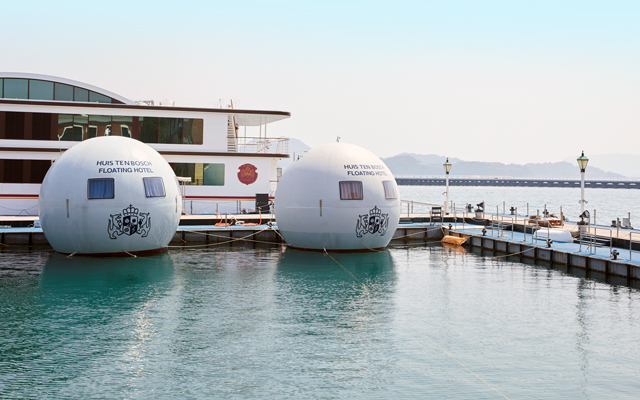With a craft beer airline, air taxis and floating hotel pods emerging in the marketplace, needless to say, the spirit of innovation is flourishing in travel this year. TTG Asia reporters bring you some of their favourites
1. Floating sphere-shaped rooms
The Huis Ten Bosch theme park in Nagasaki, Japan has unveiled spherical hotel rooms floating on the bay off the bay. Each pod is arranged over two floors, with the upper level containing a bed and the lower level a lounge area. The self-contained units also has its own bath and toilet facilities. Guests can choose to moor offshore while they are asleep or to be in gentle motion between the park and an uninhabited island nearby.

2. Air taxi trials get green light
German company Volocopter has developed air taxis for inner-city transport, with these “flying cars” already approved for trials in Singapore next year. Each electrically powered drone aircraft (Volocopter) can fly two people for distances of less than 30km, and can be manoeuvred by a pilot or remote control. The trials will test the feasibility of Volocopters and their flight modes in Singapore’s environment.


3. TUI’s robot hire
A humanoid robot named Pepper 2E in August joined TUI Nordic’s new Data Analytics and Machine Learning team in the Stockholm office. This semi-humanoid robot understands and speaks in numerous languages and can understand human emotions. Pepper’s touch screen increases his capacity to interact and enables him to enhance communication by providing visual information.
4. Morpheus descends in Macau
Named after the god of dreams in Greek mythology, Morpheus hotel debuted in Macau on June 15 as the world’s first free-form exoskeleton high-rise architectural structure, designed by the late starchitect Zaha Hadid. Apart from 770 guestrooms, suites and villas, the architectural marvel is home to Alain Ducasse at Morpheus, chef Alain Ducasse’s first restaurant in Macau.
5. The ‘Rubik’s Cube’ winery
Taking the immersive winery experience to the next level is the d’Arenberg Cube in McLaren Vale, South Australia. Inspired by a Rubik’s Cube, the five-storey building ‘floats’ among the Mourvèdre vines and features an entrance door said to spin and fold open like origami. Its five levels are designed for the senses with features including a virtual fermenter, a 360-degree video room, a wine fog room, and a flower and fruit room with puffers you can inhale of one of the 72 wines they produce.

6. ‘Craft beer airline’ now boarding
Scottish craft beer brewer BrewDog is chartering a “bespoke BrewDog Boeing 767” to cruise from London Stansted to Columbus Ohio in February 2019. On board, passengers will be treated to a new beer created to taste better at altitude. In Ohio, they will be taken on a behind-the-scene tour of BrewDog Columbus, a walking tour to discover bars in the city and a day trip to Cincinnati breweries. Tickets are for the flight are on sale now, but are available only for “Equity Punks”, or those who invested in the company during its crowdfunding round.

7. AR baggage measurement tool
Kayak’s augmented reality (AR) baggage measurement tool was created to help travellers determine whether or not their luggage will fit in the overheads bins of an airline before arriving at the airport. Available via the Kayak app on all iOS devices running iOS 11.3 and up, the tool also compares baggage fee policies for all Kayak tracked airlines.
8. Paging for home-based agents
Singapore-based Chan Brothers Group has launched the ten Travel Envoy platform (ten stands for “travel entrepreneur network”) to recruit travel agent “envoys”. Besides getting destination and product training, Envoys can earn five per cent commission per package sold. Those who wish to plan and customise FIT packages for their customers will be charged to use a premium platform from the second year. Not only does this system help Chan Brothers distribute its packages to a wider market, it also serves as an alternative to recruit travel agents, an increasingly challenging task today.
9. VR deep-dive into the Philippines
The Philippine Department of Tourism this year turned to virtual reality (VR) technology to promote dive tourism, a step up from mere photographs of the country’s underwater attractions including Tubbataha Reef, Anilao in Batangas, Malapascua and Bantayan Island in Cebu. VR goggles were made available during European sorties and international dive shows, with scenes curated by Studio H20 Philippines whose staff are all experienced scuba divers and professional underwater videographers and photographers.
10. Creative neighbourhood spotlight
Following the 2017 launch of the Old Town Central programme, Hong Kong Tourism Board picked Sham Shui Po to spotlight in its latest neighbourhood campaign this year. It turns the neighbourhood into a playground for the young and creative to discover authentic local flavours, such as by allowing visitors to scan QR codes to access information at various points of interests. A Sham Shui Po Self-guided Walks guide was also created, featuring walking routes recommended by local personalities and 65 thematic points of interest.

11. UnDiscover Australia
The challenge of attracting repeat tourists was taken head on with a new campaign inviting visitors to UnDiscover Australia. Launched in September, the A$10 million (US$7.3 million) campaign aims to challenge perceptions of Australia which is known for koalas, kangaroos, the outback and iconic landmarks, and instead showcases unusual and unexpected attractions on offer. These include climbing the roof of the Adelaide Oval to enjoy 60-degree views of the city skyline at sunset or swimming with sharks.
12. Upgrading the longhaul experience
What can an airline do to bump up the comfort level on the world’s longest air route? Well, remove economy class and put in a bevy of entertainment and meal options. That’s what Singapore Airlines did when its daily Singapore-New York service took off in October. The new Airbus A350-900ULR used to operate the ultra-longhaul flight features only premium economy and business class seats, and serves up wellness cuisine curated by chefs and nutritionists from luxury spa company Canyon Ranch.




















